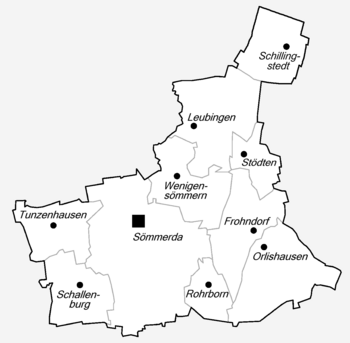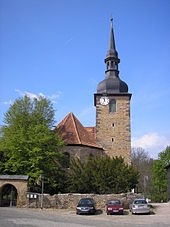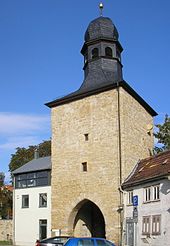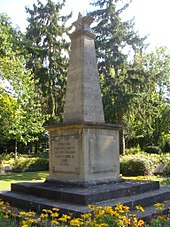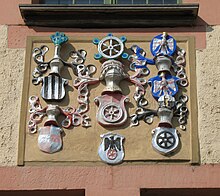Sömmerda
| coat of arms | Germany map | |
|---|---|---|

|
Coordinates: 51 ° 10 ' N , 11 ° 7' E |
|
| Basic data | ||
| State : | Thuringia | |
| County : | Sömmerda | |
| Height : | 138 m above sea level NHN | |
| Area : | 87.56 km 2 | |
| Residents: | 18,947 (Dec. 31, 2019) | |
| Population density : | 216 inhabitants per km 2 | |
| Postal code : | 99610 | |
| Area code : | 03634 | |
| License plate : | SÖM | |
| Community key : | 16 0 68 051 | |
| LOCODE : | DE SOM | |
| City structure: | 9 districts | |
City administration address : |
Marktplatz 3–4 99610 Sömmerda |
|
| Website : | ||
| Mayor : | Ralf Hauboldt ( The Left ) | |
| Location of the district town of Sömmerda in the district of the same name | ||
Sömmerda is the district town of the district of the same name in Thuringia . The city is located about 20 kilometers north of Erfurt , is a medium-sized center and was the location of the electrical industry ( Fujitsu Technology Solutions ), whose forerunners were the mechanical factories of Johann Nikolaus von Dreyse . They shaped the city significantly since 1840 and ensured the growth of the former insignificant agricultural town into an industrial town .
geography
Geographical location
|
Goslar (130 km) Nordhausen (60 km) |
Quedlinburg (110 km) Kyffhäuser (45 km) |
Berlin (300 km) Halle (Sa.) (100 km) |
|
Mühlhausen (60 km) Kassel (170 km) |

|
Naumburg / Sa. (60 km) Leipzig (120 km) |
|
Gotha (50 km) Meiningen (120 km) |
Erfurt (20 km) Ilmenau (70 km) |
Weimar (30 km) Jena (55 km) |
Sömmerda is located in the flat, fertile Thuringian Basin on the middle Unstrut . The area is used intensively for agriculture and is scarce. The climate is exceptionally dry and relatively mild.
Layers of ash, ceramic shards, bones and iron remains were found on the northeastern area of the former Weißenburg in the Tunzenhausen district. The castle at that time is probably from prehistoric times. The castle was first mentioned in 1211 with the siege of the nearby Runneburg in Weißensee. It was destroyed and rebuilt in 1248. Three trenches far in front of the main ramparts can still be seen on an aerial photo. Arched ramparts secured the castle grounds to the north to the higher plain.
The royal castle, also called Schwedenschanze, was located in the floodplain of the Unstrut just to the west of Altsömmerda, clay vessels and iron tools as well as graves were found. All finds come from the Middle Ages.
Neighboring communities
Sömmerda borders the following communities (clockwise, starting from the north): Griefstedt , Büchel , Etzleben , An der Schmücke , Kölleda , Großneuhausen , Kleinneuhausen , Vogelsberg , Sprötau , Schloßvippach , Großrudestedt , Werningshausen , Wundersleben and Weißensee .
City structure
| District | Area (km²) |
Residents |
|---|---|---|
| Sömmerda | 22.91 | 16,337 |
| Frohndorf | 8.20 | 457 |
| Leubingen | 14.49 1 | 914 |
| Orlishausen | 10.55 | 690 |
| Rohrborn | 3.47 | 157 |
| Schallenburg | 6.53 | 365 |
| Schillingstedt | 6.49 | 227 |
| Stödten | 1 | 102 |
| Tunzenhausen | 6.69 | 470 |
| Little summer | 7.82 | 294 |
| Sömmerda (total) | 80.70 | 19,786 |
1 the area of Leubingen given here contains the Stödtens
As of July 5, 2010
history

Beginnings until 1945
Sömmerda was first mentioned in a document in 876. To avoid confusion with nearby locations such as Mittelsömmern , Wenigensömmern or Gangloffsömmern to avoid the city was formerly often referred to as wholesale Sömmerda or Großensömmern. In 918 Konrad I assigned the city to the Fulda monastery . In 1342 the place came into the possession of the Grafschaft Schwarzburg , which sold it in 1418 to the city of Erfurt , to whose possession it belonged as an exclave until 1802 when it came to Prussia . Around 1350, the place probably received city rights , but this cannot be clearly proven. The Erfurter Tor, built in 1395, and six city wall towers are the oldest surviving structures in the city. The medieval town stretched in a strip along the Unstrut with two settlement centers: the northern one was around the market square and the southern one around Petriplatz. The city fortifications included both.
During the Thirty Years' War (1618-1648), the city's population fell sharply due to military activities, looting and epidemics. During the Middle Ages and early modern times, Sömmerda belonged politically to Erfurt and thus to Kurmainz . After the defeat of the Prussian army in the battle of Jena and Auerstedt , the city was under Napoleonic rule ( Principality of Erfurt ) before it came back to the Kingdom of Prussia in 1813/14 , to which it had belonged since 1802. After the Congress of Vienna in 1814/15, the creation of districts began in Prussia, which brought the city of Sömmerda to the district of Weißensee , to which it belonged until 1952.
The inventor of the needle gun, Johann Nicolaus Dreyse (von Dreyse from 1864), who was born in Sömmerda, founded the Dreyse & Collenbusch metal goods factory together with the manufacturer Kronbiegel in 1817 , which marked the beginning of industrialization in the city. In 1840 Dreyses commissioned a rifle factory to be built and in 1858 a hand- painted brickworks was founded , which at the end of the 19th century developed into one of the largest and most modern brickworks in the German Empire . The Kölleda-based Saal-Unstrut-Eisenbahn-Gesellschaft (SUE) opened the Straussfurt – Großheringen ("Pfefferminzbahn") railway in August 1874, and Sömmerda was thus connected to the railway network. The electrification followed from 1900. 1876 founded Carl Böttner one at the ring road of Soemmerda brewery . A potato flake factory was located on the site until the early 1970s .
The Munitions- und Waffenfabrik AG, Sömmerda, vorm. v. Dreyse was taken over in 1901 by Rheinische Metallwaaren- und Maschinenfabrik AG ( Rheinmetall ) in Düsseldorf. With the great demand of the German Army during the First World War , the workforce increased to 10,000 employees. The Versailles Peace Treaty made it necessary to switch to civilian products. The Rheinmetall plant in Sömmerda now manufactured precision mechanical devices such as typewriters and calculating machines. On March 24, 1920, as part of the Kapp Putsch, Reich defense units took action against workers who wanted to defend the republic. Some of them - including the veterinarian Kurt Neubert - were tortured and shot. During the Nazi dictatorship , the armaments manufacturer, which was merged with Borsig to form Rheinmetall-Borsig in 1936, experienced a renewed boom through the armament of the Wehrmacht . During the Second World War , up to 14,600 people were employed in Sömmerda, of which around 6,000 were forced laborers and prisoners of war who were housed in numerous satellite camps of the Buchenwald concentration camp in and around Sömmerda. The city remained unscathed during World War II.
From 1945
On April 11, 1945, Sömmerda was occupied by US troops. The Red Army followed on July 1, 1945 and the whole of Thuringia became part of the Soviet occupation zone .
After the founding of the GDR on October 7, 1949, the number of employees in Sömmerda, which has also been manufacturing office machines since 1919, grew steadily over the following decades, as a result of which the city's population rose sharply. In 1952 the city became the seat of the newly formed Sömmerda district , which belonged to the Erfurt district . The city had previously belonged to the Weißensee district.
Sömmerda was one of the focal points of the riot on June 17, 1953 in the Erfurt district. Strikes in large companies (especially VEB Rheinmetall) developed into demonstrations on the marketplace with 10,000 participants. The citizens demanded the resignation of the government, free elections, the removal of the inner-German border and sang the German song. The declaration of a state of emergency by the Soviet occupying power ended the uprising. 27 “rebels”, including the strike committee, were arrested and high SED functionaries dismissed because they had not shown themselves to be up to the situation. The main demand of the strikers in VEB Rheinmetall on June 18 was the release of those arrested. At a meeting in Sömmerda on June 17, 300 farmers demanded a reduction in the tax rate, the return of expropriated companies and free elections.
In 1989 the population was over 24,000. After the fall of the Wall , the office machine plant and brick production were shut down. The current computer manufacturing plant of Fujitsu Technology Solutions (up to 2008 under the name Fujitsu Siemens Computers ) developed from the electrical engineering combine Robotron , which was founded in GDR times .
In 2005 Sömmerda won the silver medal in the national competition “ Our city is in bloom ”.
Incorporations
On March 14, 1974, Wenigensomern and Rohrborn were incorporated . Schallenburg was incorporated on May 6, 1993, Frohndorf , Leubingen , Orlishausen , Tunzenhausen and Stödten followed on March 8, 1994, and Schillingstedt followed on July 6, 2018 .
Population development
Development of the population (from December 31, 1960) :
|
1839 to 1946
|
1950 to 1996
|
1997 to 2003
|
2004 to 2010
|
2011 to 2017
|
from 2018
|
- Data source from 1994: Thuringian State Office for Statistics
1 October 29th
2 August 31st
politics
City council
Since the local elections on May 26, 2019, the Sömmerda City Council has been composed as follows:
- LEFT : 8 seats
- CDU : 6 seats
- AfD : 3 seats
- SBB (Sömmerda Citizens' Alliance): 2 seats
- GREEN : 2 seats
- SPD : 1 seat
- BIS (Citizens' Initiative Sömmerda e.V.): 1 seat
- FDP : 1 seat
The city council members of the CDU and FDP, the Greens and the SPD as well as the SBB and BIS each form a joint parliamentary group, so that five parliamentary groups are represented in the city council. In addition to the city council members, the mayor of Sömmerda is also entitled to vote.
mayor
The full-time mayor has been Ralf Hauboldt (Die Linke) since 2012 . It was last confirmed on April 15, 2018 with 60.8% of the valid votes cast in the first ballot.
Former Mayor (since 1994)
- 1994–2000: Erwin Bollinger (independent)
- 2000–2012: Hans-Wolfgang Flögel (initially PDS , later Die Linke)
coat of arms
Blazon : “Divided by silver and red; above a black, red-tongued eagle looking right, below a six-spoke silver wheel. "
Meaning: The eagle stands for the Kingdom of Prussia . The wheel, which shows the Erfurt coat of arms, indicates the eventful history of Sömmerda, as the city was owned several times by the city of Erfurt.
flag
The flag of the city of Sömmerda is striped with red and silver (white) and carries the city coat of arms.
Town twinning
Culture and sights
museum
Since 2005, the so-called Dreyse House has housed a museum and the city and district library. The museum shows the industrial development of the city and the life of Johann Nikolaus von Dreyse , who lived in this house. In the back yard of the building there is a rose garden that was replanted in the style of the 19th century.
Buildings
- Around 1368 erection of a fortification called "Mitliln Tor". A city gate, the “Erfurter Tor” from 1395, which has housed a museum since 1977, and six city wall towers are still preserved today. The oldest gate, which is no longer preserved, dates from 1389 and was called the “Wenigens summer gate”. The city wall was a total of 1,300 m long, 4 m high and 0.85 m thick. It was built around 1600 with five gates and a “Werrchenpforte”, a single-leaf gate, while the others were built as a gatehouse.
- The Protestant town church Bonifatius . The late Gothic, single-nave building dates from between 1462 and 1567. The pastors and mayors of the city were buried in its crypt until 1804. In addition to the baroque organ, the inventory also includes two gilded altarpieces from 1491. The tower is a square choir flank tower.
- The rectory of the Bonifatiuskirche on the north side of the market square is a stately half-timbered building that has been renovated since 1993. It was built as an office building in 1589 and acquired as a rectory by the Protestant church in 1792.
- Christian Gotthilf Salzmann's birthplace is also on the north side of the market square . A monument in front of the Bonifatiuskirche commemorates him.
- The house where Johann Nikolaus Dreyse was born is located on Langen Strasse near the market .
- The Evangelical Petrikirche is located south of the Bonifatiuskirche. In the Middle Ages, a second settlement core was formed around them, which was also included in the city wall. This church replaced a previous building from 1400 in 1685, the current church tower was not completed until 1716.
- The Catholic parish church of St. Franziskus was built as a north-facing hall building with a south tower in 1893 in the neo-Gothic style . It replaced a previous building, which was designed as a half-timbered church and was built in 1862. The inventory of this church includes a crescent moon Madonna, which was created around 1490 in southern Germany.
- The town hall on the market is a Renaissance building from 1539. The surrounding market square and Marktstrasse were redesigned between 1967 and 1975. The old perimeter development was demolished and replaced by four-story residential buildings in a contemporary style. The designs for this came from the architects Wagner and Steinecke.
- In the Lohmühle , built around the end of the 19th century in neoclassical style, grain was ground until the 1950s. The Dreysemühle is right next to it.
- A 35 m high water tower was built in the industrial park in 1917 to supply Rheinmetall Borsig AG . Along with the Erfurt Gate, it is a symbol of the city.
- The Stadtparkbrücke , built in 1904, connects the old town with the Stadtpark that was laid out a year earlier. The covered wooden bridge leads over the Unstrut.
- Also worth seeing is the Gartenbergsiedlung in the north of the city, which was built between 1914 and 1918 in the style of a garden city .
Parks
- city Park
- Brickyard Park
- "Green classroom" cultural park
Regular events
- spring Festival
- Parkfest, city festival during the festival week (June)
- Sömmerda rafting on the Unstrut whitewater canal (September): Since 1992 , rafting on the whitewater canal, organized by the local editorial team of Thüringer Allgemeine and the Canoe Club Sömmerda, has become a popular event with an ever-increasing number of participants.
- Sömmerda Culture Days
Sports
The city's best-known sports club is the FSV Sömmerda football club .
- Kurt-Neubert-Sportpark Fichtestrasse sports facility
- Unstruthalle , three-field hall
- Canoe Canal Sömmerda
Historical monuments
In 1921, at the instigation of the Social Democrats, a monument made of tuff was erected in the cemetery and given a bronze plaque commemorating the workers murdered in the Kapp Putsch in 1920.
In the cemetery on Kölledaer Strasse, a grove of honor with an obelisk commemorates 123 prisoners of war from the Soviet Union who were victims of forced labor . There were also 38 prisoners of war from several other countries. A memorial stele for the death march by concentration camp prisoners from Buchenwald was erected in Uhlandstrasse in 1984 .
1948 was by Wilhelm wall cutter derived Dreyse monument with the inventor Dreyse eliminated and a soldier at the same time a monument in memory of the war in 1864, was in 1866 and 1870-71. Only the base and a head fragment by Dreyse have survived.
Attentive pedestrians will discover stumbling blocks in the sidewalk at Anger, No. 1, and in low summer .
Economy and Infrastructure
The most important branch of the Sömmerda economy is the electrical industry . In the 20th century, Sömmerda was the work center of the Rheinmetall-Borsig AG company. During the GDR era, the Robotron combine - later called Büromaschinen AG - was located here. The current factory for the production of PCs and notebooks by Fujitsu Technology Solutions can be seen as its successor . The automotive supplier Trimet Aluminum AG is also based in Sömmerda .
There are also various companies that process agricultural products from the area. Between 1930 and the mid-1980s, the Amalienbrunnen mineral water was bottled in Sömmerda , after which the spring became contaminated, so that production was discontinued.
media
In Sömmerda, the Thüringer Allgemeine appears with a local edition for the Sömmerda district. The chess magazine Rochade Europa is also published in Sömmerda .
Public facilities
- Sömmerda District Court
- KMG Sömmerda Clinic
- District Craftsmen
- court House
- Agricultural Office
education
- State primary school "A. Diesterweg "
- State primary school "Lindenschule"
- Evangelical primary school in Sömmerda
- State school "Albert Einstein"
- State regular school “Ch. G. Salzmann "
- State high school "Albert Schweitzer"
- State-recognized special school "Finneck-Schule"
- "Rothenbach School" support center
- State Vocational School Sömmerda
- Sömmerda District Adult Education Center
- Municipal music school "Wilhelm Buchbinder"
- Thuringian toy library Sömmerda
- BBZ Sömmerda gGmbH
traffic
Rail transport
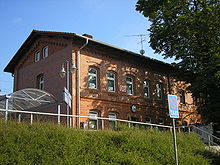
Sömmerda received its rail connection in 1881 with the Sangerhausen – Erfurt railway line , which is now electrified. A second railway line through Sömmerda is the Pfefferminzbahn , opened in 1874 , which leads to Straussfurt in the west and to Kölleda and Großheringen in the east . At the intersection of the two lines is the Sömmerda train station , which is the only tower train station in Thuringia. Passenger traffic on the western section of the Pfefferminzbahn between Straußfurt and Sömmerda was discontinued in 2007, followed by the eastern section between Buttstädt and Großheringen in 2017.
The following lines operate in Sömmerda in the 2018 timetable:
- RE 10 Erfurt – Sömmerda – Sangerhausen– Güsten - Magdeburg (every two hours alternating with RB 59) ( DB Regio )
- EB 27 Sömmerda – Buttstädt (every two hours) ( Erfurter Bahn )
- RB 59 Erfurt – Sömmerda – Sangerhausen (every two hours, alternating with RE 10) ( Abellio Rail Central Germany )
Road traffic
Sömmerda is on the B 176 , which connects Straussfurt in the west with Kölleda in the east. Sömmerda is connected to the A 71 , which connects Schweinfurt in the Bavarian Lower Franconia via the Thuringian Forest and Erfurt with Sangerhausen . This provides a quick connection between the city and the Halle area.
Bicycle traffic
Sömmerda is located on the Unstrut cycle path and on the mill hiking path .
Personalities
- Michael Altenburg (1584–1640), theologian and composer, pastor in Sömmerda
- Johann Christian Ernesti (1695–1769), theologian, pastor in Frohndorf
- Christian Gotthilf Salzmann (1744–1811), Protestant pastor and educator
- Johann Nicolaus von Dreyse (1787–1867), designer, inventor and entrepreneur
- Georg Friedrich Carl Kölling (1825–1872), sculptor
- Gustav Reischel (1858–1932), educator and desert researcher
- Arnold Paulssen (1864–1942), politician (DDP), first leading minister of state (Prime Minister) of Thuringia
- Carl Bergmann (1874–1935), banker and undersecretary of state
- Kurt Neubert (1878–1920), veterinarian and resistance fighter against the Kapp Putsch
- Otto Lange (1878–1956), elementary school teacher, painter
- Berthold Stölzer (1881–1943), sculptor
- Louis Stange (1888–1971), engineer and weapons designer at Rheinmetall-Sömmerda
- Gustav Tauschek (1899–1945), pioneer of computer science, developed the first complete punched card accounting system at Rheinmetall in Sömmerda
- Werner Jacobs (1913–2007), Catholic theologian, pastor in Sömmerda
- Erich Pätzold (* 1930), politician (SPD), former Berlin Senator for the Interior as well as for Health and Environmental Protection
- Gerd Fesser (* 1941), German historian
- Reinhold Andert (* 1944), songwriter, author
- Walter Hofmann (* 1949), canoeist, Olympic champion in canoe slalom
- Fred Marhenke (* 1950), judoka
- Peter Albach (* 1956), politician (CDU)
- Thomas Linke (* 1969), football player
- Cathlen Gawlich (* 1970), actress and voice actress
- Andreas Német (* 1973), children's book illustrator
- Maria Groß (* 1979), cook, awarded a Michelin star
- Dirk Orlishausen (* 1982), football player
- Robert Paul (* 1984), football player
- Lea Sophie Barth (* 1998), canoeist
Others
Sömmerda is in the area of distribution of the Central Thuringian dialect, which is one of the Thuringian-Upper Saxon dialects .
Individual evidence
- ^ Population of the municipalities from the Thuringian State Office for Statistics ( help on this ).
- ↑ Michael Köhler: Thuringian castles and unpaved prehistoric and prehistoric places. Jenzig-Verlag Köhler, Jena 2001, ISBN 3-910141-43-9 , pp. 270-271.
- ↑ Michael Köhler: Thuringian castles and fortified prehistoric and early historical living spaces. Jenzig-Verlag Köhler, Jena 2001, ISBN 3-910141-43-9 , p. 162.
- ↑ Heinz Mestrup: popular uprising or subversion. In: Heinz Mestrup: On the history of the district of Erfurt (1952–1990) (= Thuringia. Blätter zur Landeskunde. 45, ZDB -ID 1316491-0 ). State Center for Political Education Thuringia, Erfurt 2004, pp. 6–8, ( digitized version (PDF; 268 kB)).
- ↑ The cry for freedom. June 17th in Thuringia . Exhibition by the Ettersberg Foundation in the Thuringian Parliament in Erfurt in June 2012.
- ^ Secret report of the district authorities of the People's Police in Erfurt from June 29, 1953 on June 17 .
- ^ Thuringian State Office for Statistics: Elections in Thuringia, municipal council elections 2019 in Thuringia, final result city of Sömmerda. Retrieved August 7, 2019 .
- ^ Sömmerda city administration: Members of the city council. Retrieved August 7, 2019 .
- ^ Thuringian State Office for Statistics: Elections in Thuringia, Mayoral election 2018 in Thuringia, final result city of Sömmerda. Retrieved August 7, 2019 .
- ^ Thuringian State Office for Statistics: Elections in Thuringia, Mayoral elections in Thuringia, Sömmerda results since 1994. Retrieved on August 8, 2019 .
- ↑ Thuringian Association of the Persecuted of the Nazi Regime - Association of Antifascists and Study Group of German Resistance 1933–1945 (Ed.): Local history guide to sites of resistance and persecution 1933–1945. Volume 8: Thuringia. VAS - Verlag für Akademische Schriften, Frankfurt am Main 2003, ISBN 3-88864-343-0 , p. 277.
- ↑ mdr.de: KMG clinics take over DRK hospitals in Bad Frankenhausen, Sondershausen and Sömmerda | MDR.DE. Retrieved December 13, 2019 .
- ↑ Change of position: Tim Wozniak presented as managing director of KMG Klinikum Sömmerda. Retrieved December 13, 2019 .
- ↑ KMG Klinikum Sömmerda | Modern medicine for your health. Retrieved December 13, 2019 .
- ↑ https://www.nordhausen.de/news/news_lang.php?ArtNr=22102
literature
- O. Hesse: From Sömmerdas past and present. Attempts to compile the historical events. sn, Erfurt 1898, ( digitized version ).
- Dietrich Wolf: Sömmerda yesterday - today. Images from the past and present of the city and its surroundings. DESOTRON-Verlags-Gesellschaft, Erfurt 1994, ISBN 3-9803931-0-0 .
- Bärbel Albold: Sömmerda. Small town and industrial location 1890–1930. Sutton, Erfurt 1998, ISBN 3-89702-068-8 .
- Günter Fromm : The Sömmerda railway junction and its routes. The Sömmerda railway junction and its routes. The Saal-Unstrut-Bahn, the Sangerhausen - Erfurt railway, the Oberröblingen - Allstedt railway, the "purposes" from Rastenberg to Buttstädt, the Finnebahn Kölleda - Laucha / U., The development of the Sömmerda station. Revised and partially supplemented by Michael U. Kratzsch-Leichsenring. Rockstuhl, Bad Langensalza 1999, ISBN 3-932554-59-0 .
- Bärbel Albold: Sömmerda industrial history. 1816 to 2006. Sutton, Erfurt 2007, ISBN 978-3-86680-157-8 .



